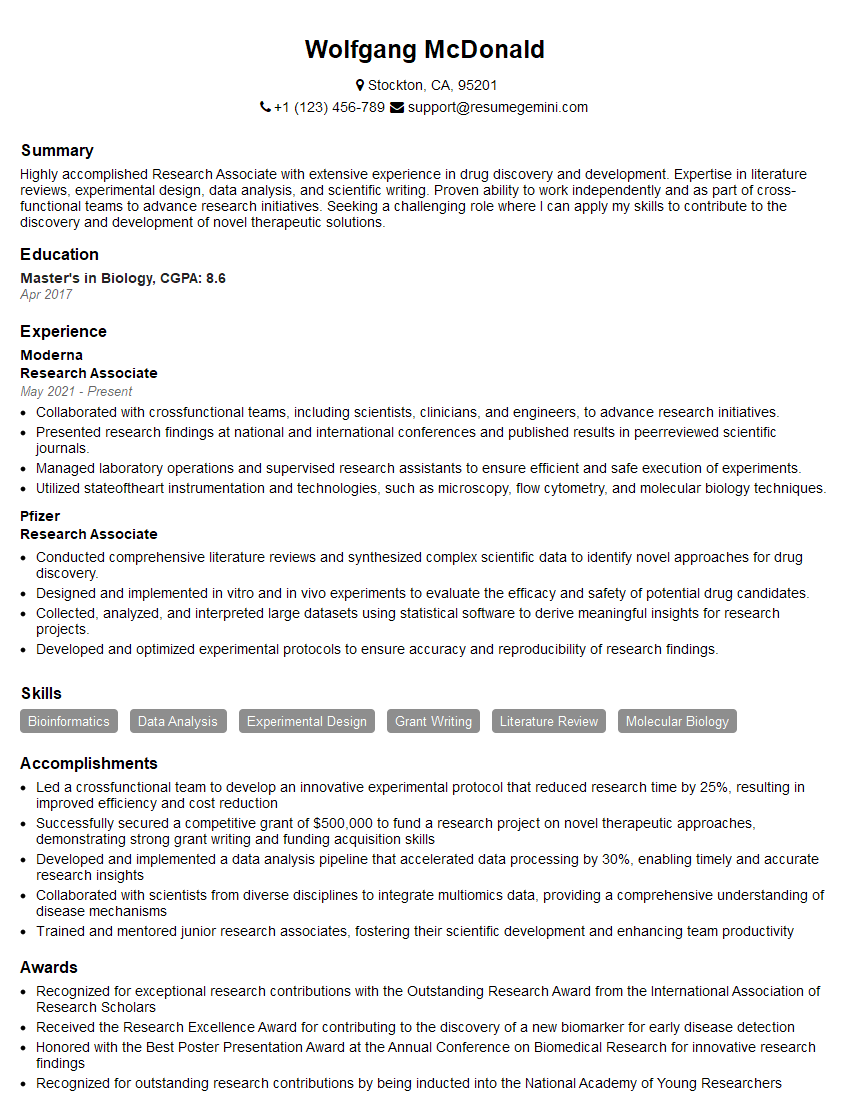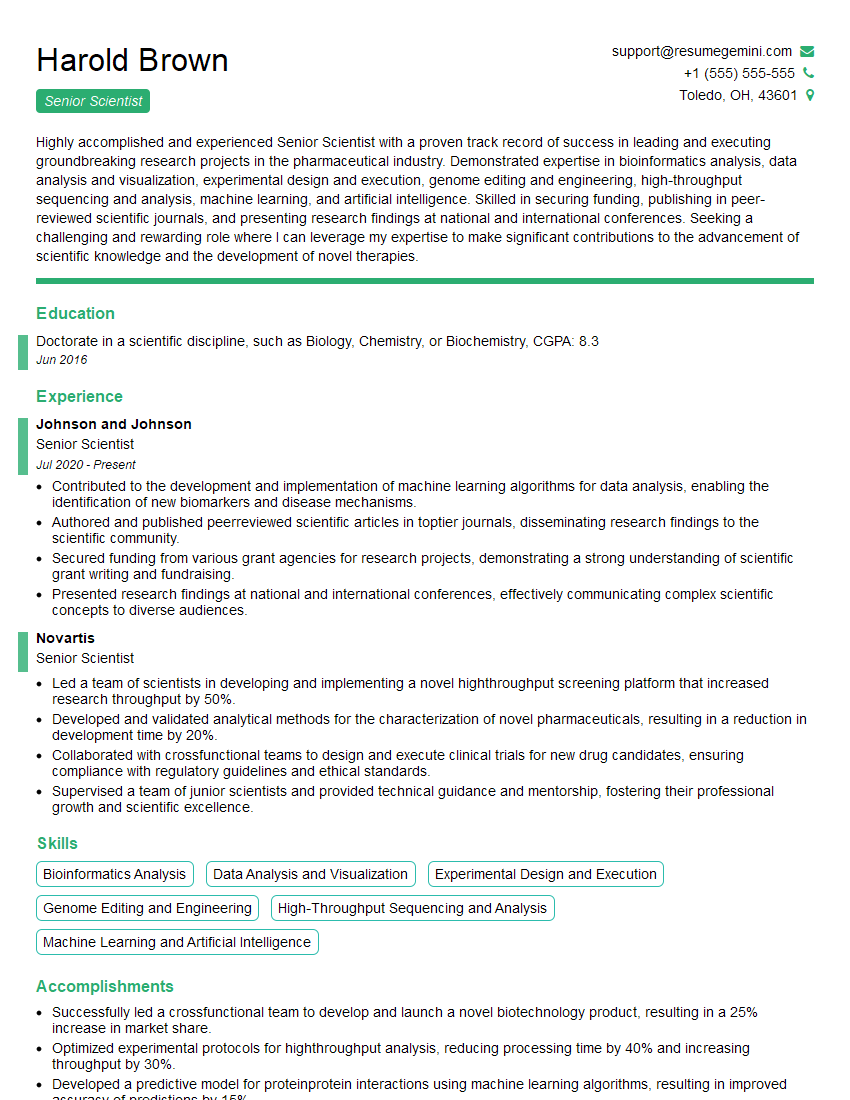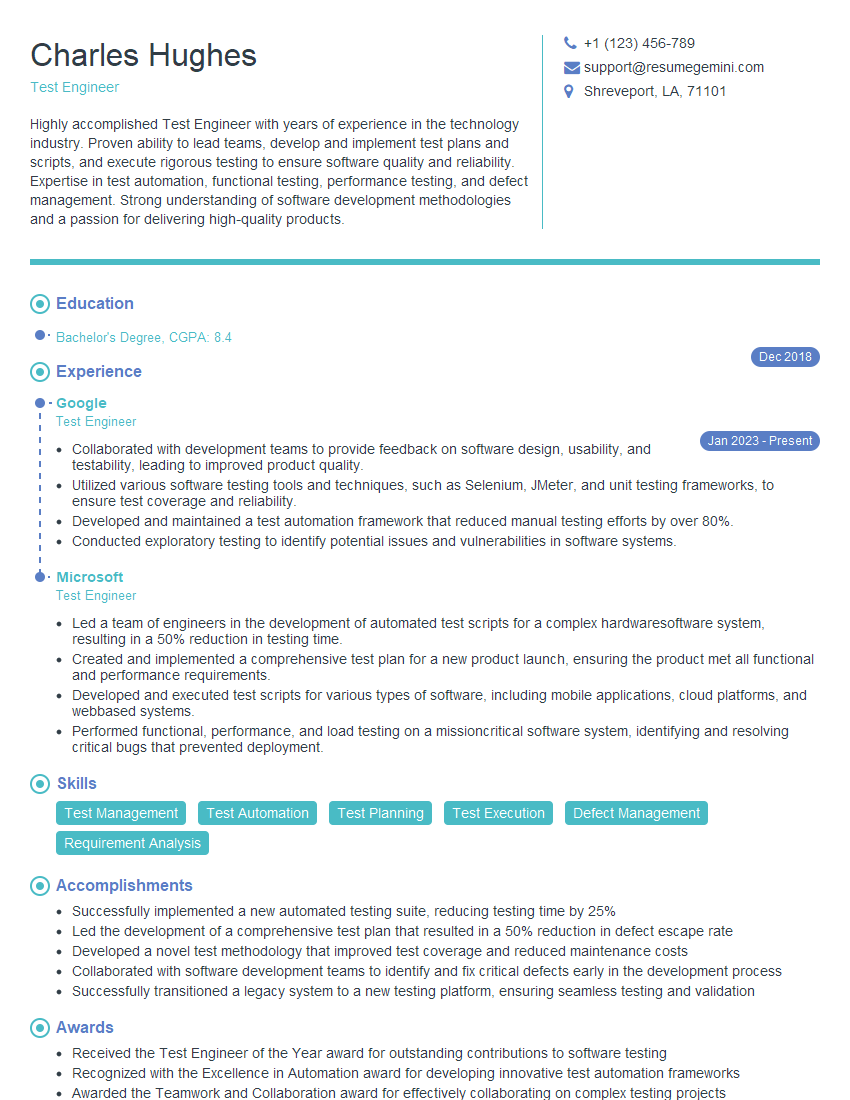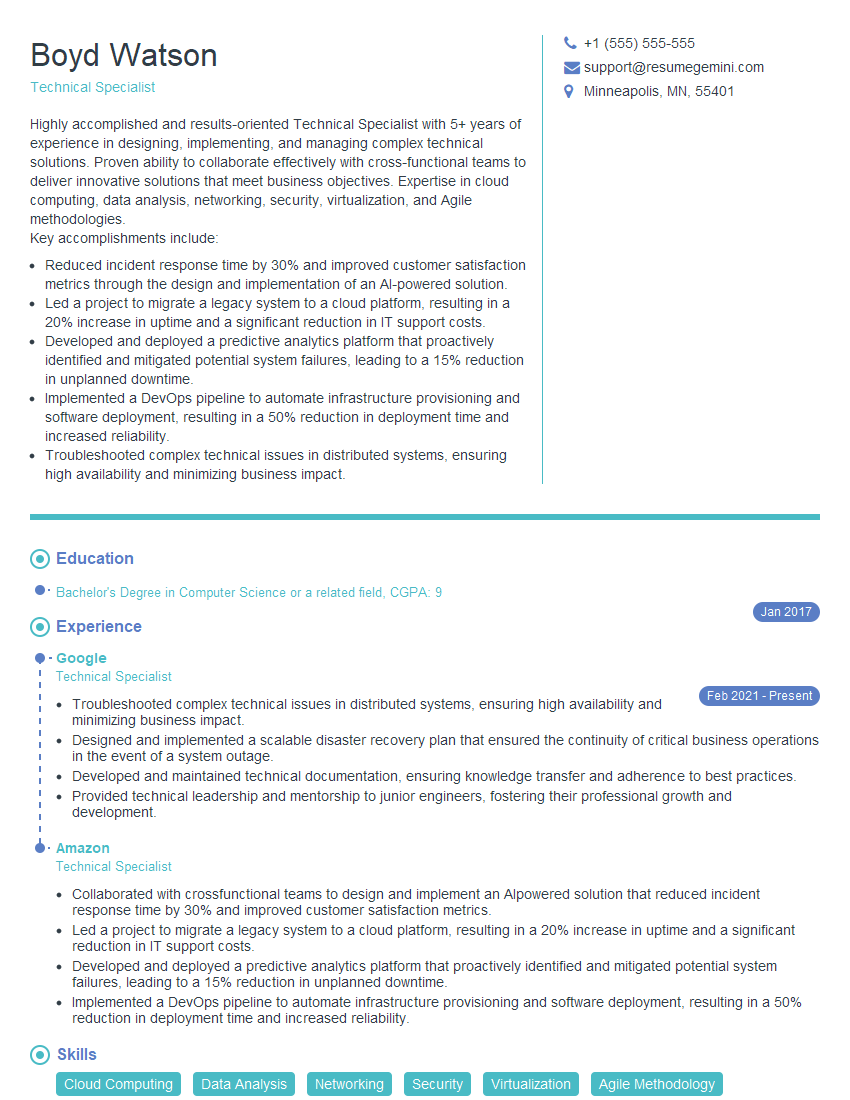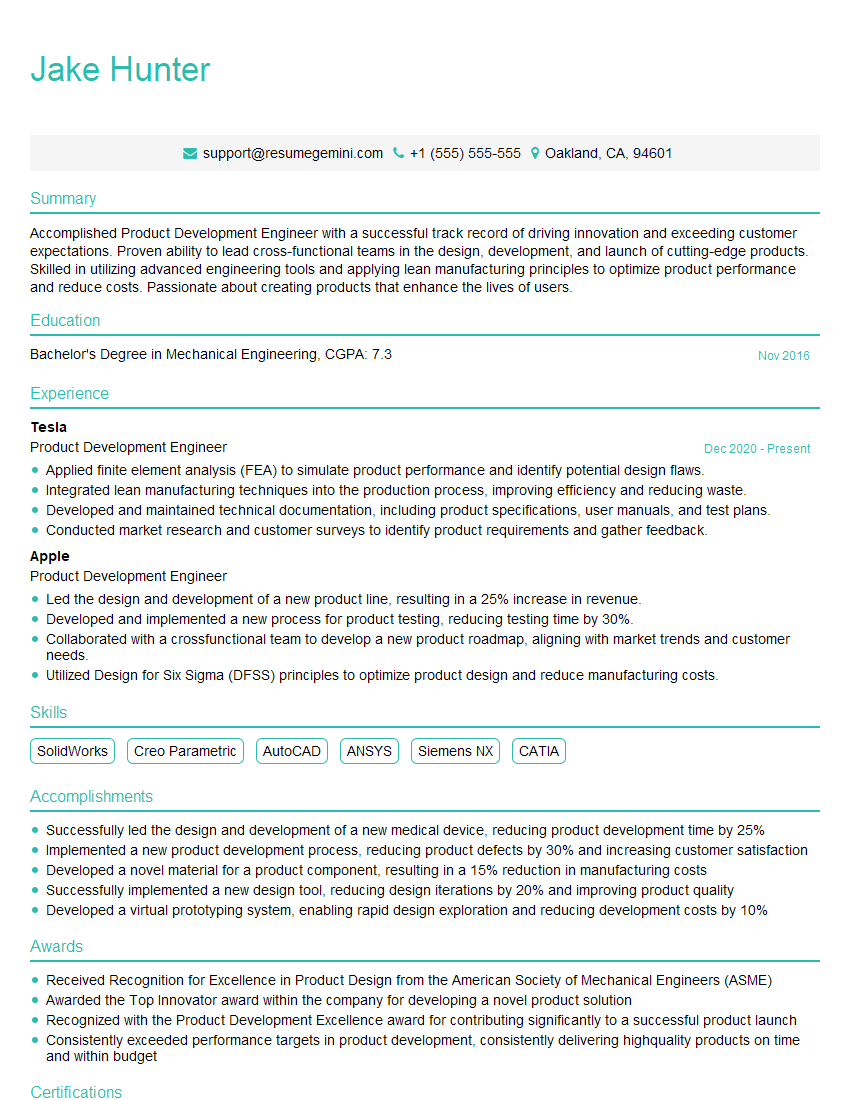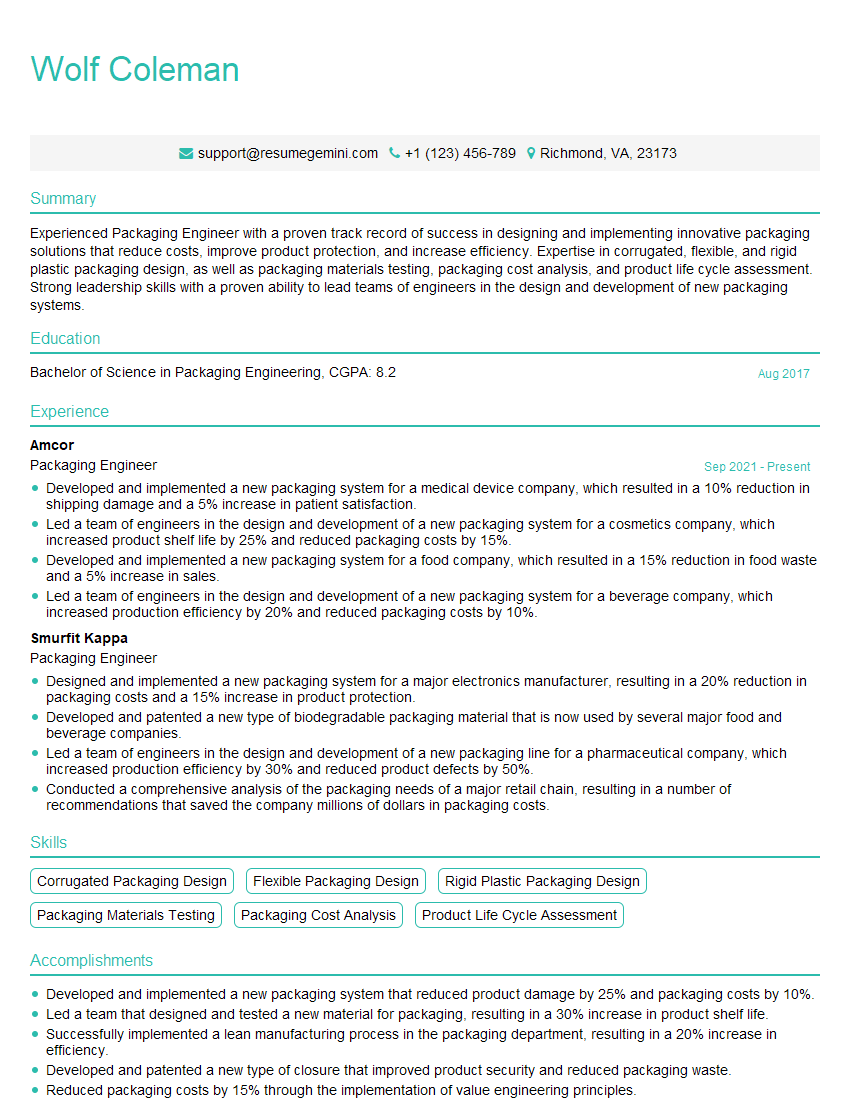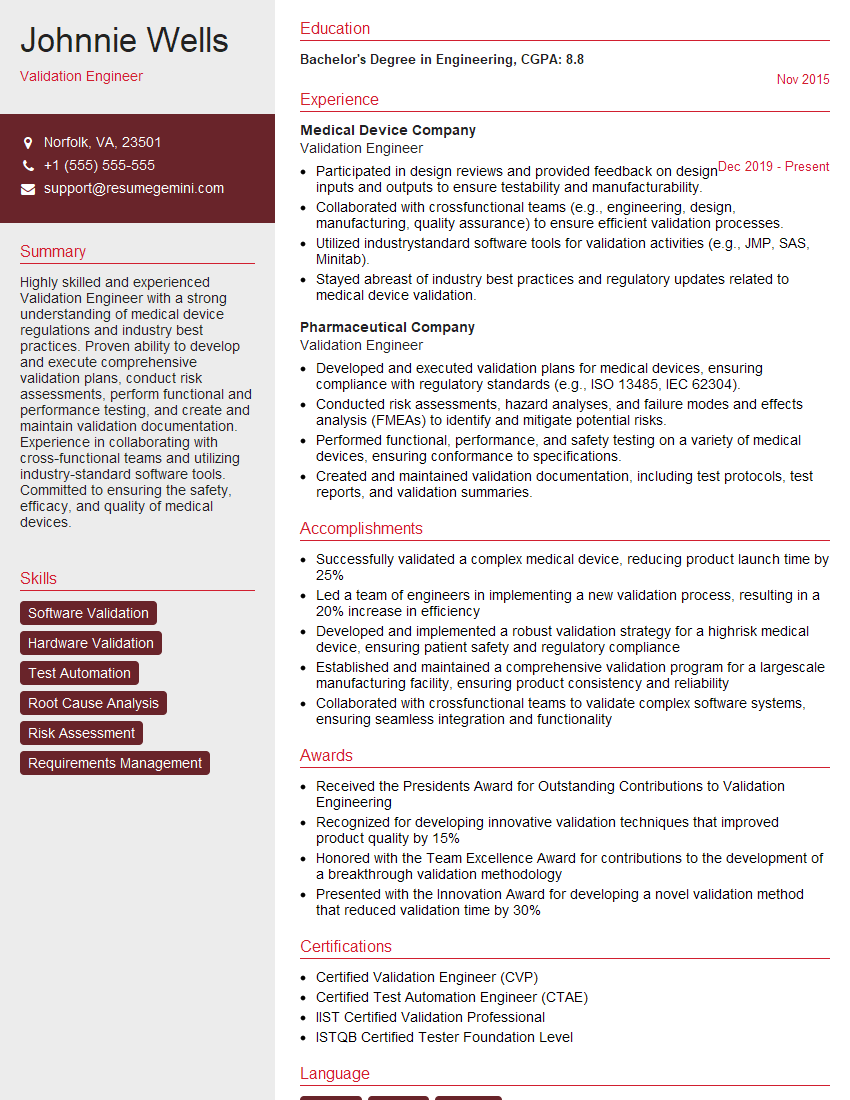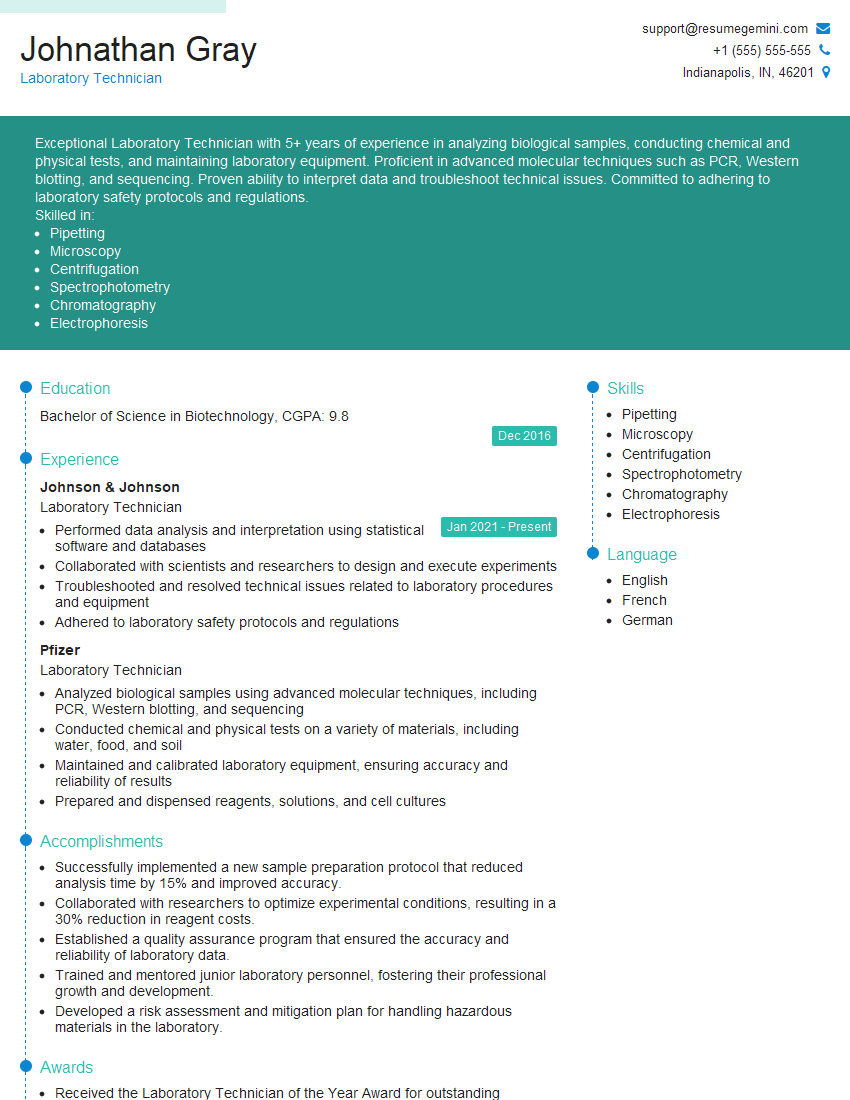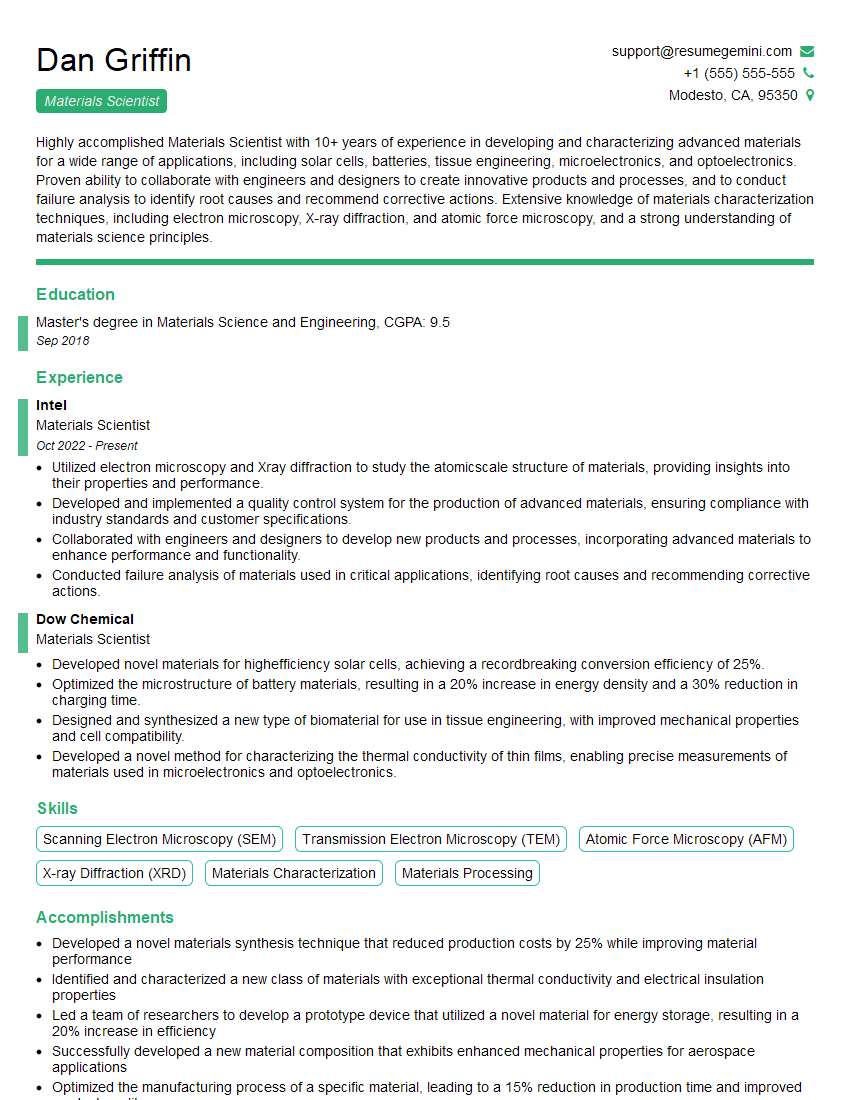Feeling uncertain about what to expect in your upcoming interview? We’ve got you covered! This blog highlights the most important Tear Index Determination interview questions and provides actionable advice to help you stand out as the ideal candidate. Let’s pave the way for your success.
Questions Asked in Tear Index Determination Interview
Q 1. Explain the principle behind Elmendorf tear strength testing.
The Elmendorf tear strength test measures the force required to propagate a tear in a material after an initial cut has been made. It’s based on the pendulum principle. A pendulum with a specified weight swings down and tears the specimen. The energy absorbed during the tearing process is measured, indirectly indicating the material’s resistance to tearing. Think of it like this: imagine swinging a weighted axe – the more energy it takes to split the wood (the material), the tougher the wood is to tear.
The instrument measures the angle of the pendulum’s swing before and after tearing the sample. The difference in these angles is directly proportional to the energy absorbed during the tear. This energy value is then used to calculate the tear strength.
Q 2. What are the limitations of the Elmendorf tear test?
While the Elmendorf test is widely used, it does have limitations. One key limitation is its sensitivity to specimen preparation. Even slight variations in cutting, clamping, or sample handling can significantly affect the results. The test also only provides a measure of tear propagation, not the initial resistance to tearing. It’s also less suitable for highly flexible or extensible materials, as their elasticity can interfere with accurate measurements. Finally, the test doesn’t capture the complexity of tear behavior in all materials. Some materials may exhibit different tear resistance depending on the direction of the tear or the presence of defects.
Q 3. Describe different types of tear tests and their applications.
Several tear tests exist, each with specific applications. The Elmendorf test, as discussed, is common for relatively stiff materials like paper, films, and textiles. The trouser tear test, another popular method, involves tearing a specimen with two slits cut in it, mimicking a trouser leg. It’s particularly useful for flexible fabrics. For evaluating the tear resistance of rubbers and elastomers, the crescent tear test is often employed. This test uses a crescent-shaped specimen and measures the force required to propagate a tear along its curved edge. The choice of test depends heavily on the material’s properties and the application’s needs. For example, a packaging manufacturer might use Elmendorf for testing film strength, while an apparel manufacturer might prefer a trouser test for fabric durability.
Q 4. How does specimen preparation affect tear index results?
Specimen preparation is crucial for reliable Elmendorf tear index results. Inconsistencies in sample size, shape, and handling will directly influence the energy absorbed during the test. Factors such as the sharpness of the initial cut (a blunt cut can initiate a different tear propagation than a sharp cut), the positioning of the specimen within the clamps, and even the presence of wrinkles or creases in the sample will lead to inaccurate measurements. Properly conditioning the sample to standard humidity and temperature is also vital to avoid variations caused by moisture content changes. Precise and standardized cutting techniques are necessary to achieve reproducible results.
Think of it like this: if you’re trying to measure the strength of a piece of wood by breaking it, the way you hold the wood will significantly affect how much force is required to break it. Similarly, inconsistencies in sample preparation will impact the Elmendorf tear test results.
Q 5. What are the units used to express tear index?
The tear index is usually expressed in grams per millimeter (g/mm) or pounds per inch (lb/in). The units represent the force or energy required to propagate a tear, normalized by the thickness of the material. This normalization allows for comparison between materials of different thicknesses. For instance, a thicker material may require a larger force to tear, but its tear index might be lower than a thinner material if the thinner material offers better resistance relative to its thickness.
Q 6. Explain the significance of conditioning samples before tear testing.
Conditioning samples before tear testing is essential to ensure consistent and reliable results. Materials absorb moisture from the environment, which can significantly affect their mechanical properties, including tear resistance. Variations in humidity and temperature can lead to significant differences in test outcomes. Standard conditioning procedures usually involve maintaining the samples at a specified relative humidity (e.g., 50%) and temperature (e.g., 23°C) for a set period before testing. This ensures that all samples are tested under the same environmental conditions, minimizing the variability introduced by moisture content differences and providing more meaningful comparisons.
Q 7. How do you interpret a tear index value?
Interpreting a tear index value depends on the context, specifically the material being tested and its intended application. A higher tear index generally indicates greater tear resistance. However, a ‘high’ or ‘low’ value is relative. For instance, a high tear index for a thin plastic film is desirable for packaging applications where puncture resistance is key. On the other hand, a high tear index for a flexible fabric might indicate stiffness and reduced drapability, potentially undesirable for clothing. Therefore, the significance of a tear index value should always be interpreted relative to the expected performance requirements of the material in its application.
Comparing tear index values between different batches of the same material is also crucial for quality control. Significant variations in tear index might indicate process inconsistencies or material defects.
Q 8. What are the factors that influence tear strength?
Tear strength, a crucial property of materials, represents a material’s resistance to tearing or ripping propagation when a cut or tear is initiated. Several factors significantly influence this strength. Think of it like trying to rip a piece of fabric – some fabrics tear easily, others resist.
- Fiber properties: The type of fiber (e.g., cotton, nylon, polyester), its length, orientation, and fineness directly affect tear resistance. Stronger, longer, and more uniformly oriented fibers create a stronger material.
- Polymer structure and molecular weight: In plastics and films, the polymer’s molecular weight and its chain arrangement influence tear strength. Higher molecular weight typically equates to higher tear resistance. Imagine a long chain – harder to break than a short one.
- Material density and thickness: Thicker materials naturally exhibit higher tear resistance than thinner ones. More material means more fibers or polymer chains to break.
- Processing conditions: The manufacturing process significantly impacts tear strength. Improper processing (like uneven heat distribution in extrusion) can create weak points, lowering overall tear resistance.
- Additives and fillers: The addition of plasticizers, reinforcing agents, or other fillers alters the material’s structure and thus its tear strength. Think of adding reinforcements to concrete – it becomes stronger and harder to break.
- Environmental factors: Temperature and humidity can influence tear resistance, with some materials becoming more brittle and prone to tearing at extreme temperatures or humid conditions. Just as a dry piece of paper is easier to tear than a damp one.
Q 9. How can you ensure accurate and reliable tear index measurements?
Ensuring accurate and reliable tear index measurements requires meticulous attention to detail throughout the testing process. It’s not just about the machine, but also about the sample preparation and testing procedure.
- Proper sample preparation: Sample dimensions must precisely follow the standard test methods (ASTM D624 or ISO 6383, for instance). Accurate cutting and conditioning are crucial. Inconsistent sample size leads to unreliable results.
- Calibration of the tear strength tester: Regular calibration is essential using certified weights or other standards to ensure the instrument’s accuracy. It’s like calibrating a kitchen scale to be sure your measurements are correct.
- Selection of appropriate test method: The choice of test method (Elmendorf or trouser methods, for example) depends on the material type and its thickness. Using the wrong method gives you an invalid result.
- Multiple specimens: Testing multiple specimens (at least five) and analyzing the statistical distribution (average, standard deviation) improves reliability and helps identify outliers. More samples allow us to see the true average tear strength.
- Control of environmental conditions: Temperature and humidity can significantly impact tear strength measurements. Consistent testing conditions help to minimize variability.
- Operator skill: Proper handling and clamping of the samples are vital for achieving accurate and reliable measurements. Operator training and consistent procedures are vital to obtaining repeatable results.
Q 10. Describe the calibration procedure for a tear strength tester.
Calibration of a tear strength tester is a critical step to ensure accurate measurements. The procedure varies slightly depending on the tester’s make and model, but the principles remain the same.
- Consult the instrument’s manual: The manufacturer’s instructions provide a detailed and specific calibration procedure.
- Prepare calibration weights or standards: Use certified weights or traceable standards that match the tester’s capacity.
- Zero calibration: Set the instrument to zero with no load applied.
- Load calibration: Apply the calibration weights to the tester and record the readings. Verify the displayed values match the known weights, adjusting the instrument as needed.
- Regularity: Calibration should be done regularly (e.g., daily or weekly) based on the instrument’s use and manufacturer’s recommendations, to ensure its accuracy over time. A well-maintained instrument is a reliable instrument.
- Documentation: Keep detailed records of the calibration process, including the date, weights used, readings obtained, and any adjustments made. This is essential for traceability and regulatory compliance.
Q 11. What are common sources of error in tear index determination?
Several sources of error can affect tear index determination, leading to inaccurate or unreliable results. Identifying these potential pitfalls is key to improving the accuracy of testing.
- Improper sample preparation: Uneven cutting, incorrect sample dimensions, and inadequate conditioning are significant sources of error. This leads to inconsistency across tests.
- Instrument malfunction or improper calibration: A faulty tear tester or an inadequately calibrated instrument will produce erroneous results. Regular maintenance and calibration are essential.
- Environmental factors: Variations in temperature and humidity can impact tear strength. Maintaining consistent environmental conditions is critical.
- Operator error: Incorrect sample handling, improper clamping, or inconsistent testing procedures can introduce errors. Standardized procedures are key.
- Specimen defects: Flaws or imperfections in the material (e.g., holes, inclusions) affect tear strength and introduce bias into the results.
- Outliers in data: Individual readings that are significantly different from the rest can skew the average. Careful data analysis and outlier detection techniques are crucial.
Q 12. How do you handle outliers in tear strength data?
Outliers, data points significantly different from others, can skew the results. Handling them requires careful consideration.
- Investigation: The first step is investigating the cause of the outlier. Was there a procedural error, a specimen defect, or an instrument malfunction? Finding the cause is crucial.
- Visual inspection of data: Use a scatter plot or box plot to visualize the data and identify outliers graphically. This allows for easy identification of points that deviate significantly.
- Statistical analysis: Statistical tests, like the Grubbs’ test, can be used to determine if an outlier should be rejected. These tests provide a quantitative basis for outlier removal.
- Exclusion: If a valid reason is found (e.g., a clear procedural error), the outlier can be excluded from the analysis. But this must be justified and documented.
- Reporting: Always report the number of tests performed and whether any data points were excluded and why. Transparency is essential in maintaining the integrity of the results.
- Alternative analyses: Consider using statistical methods like median instead of mean, which is less sensitive to outliers. The median represents the middle value in the sorted dataset and is more resistant to outliers than the mean.
Q 13. Explain the difference between tensile strength and tear strength.
Tensile strength and tear strength are both measures of material strength but assess different aspects.
Tensile strength measures a material’s resistance to being pulled apart when a force is applied along its axis. Imagine stretching a rubber band until it breaks – that’s tensile strength. It describes the force needed to break an intact material.
Tear strength, in contrast, measures the material’s resistance to the propagation of a pre-existing cut or tear. It’s about how easily a cut continues to rip through a material. Imagine tearing a piece of paper – that’s tear strength. It focuses on resisting the growth of existing tears or flaws.
While related, these properties are distinct. A material may have high tensile strength but low tear strength, or vice versa. For example, a brittle material might have high tensile strength but be prone to tearing once a crack initiates.
Q 14. What is the importance of tear index in material selection?
Tear index is a critical property in material selection, particularly in applications where resistance to tearing or ripping is crucial.
- Packaging: In packaging materials, high tear resistance ensures product integrity and prevents accidental opening or damage during transport and handling. A weak tear strength in packaging could lead to spills or damage.
- Textiles: Tear strength is vital in fabrics used for clothing, upholstery, and other applications, determining durability and longevity. A garment tearing easily would be unacceptable to consumers.
- Plastics and films: For plastic films used in agriculture or construction, tear resistance is essential for preventing rips and maintaining structural integrity. A plastic film tearing easily would be a failure for intended applications.
- Geotextiles: In geotechnical applications, tear resistance ensures the longevity and stability of geotextiles used for soil stabilization or reinforcement. A tear in a geotextile could lead to structural instability.
- Medical applications: Materials used in medical devices or implants need adequate tear strength to prevent failure and ensure patient safety.
The tear index provides a quantitative measure to compare different materials and select the most suitable one for a given application, ensuring the product or structure’s performance and reliability.
Q 15. How is tear index related to the molecular structure of a polymer?
The tear index, a measure of a material’s resistance to tearing, is intrinsically linked to its molecular structure. Stronger intermolecular forces within the polymer chains lead to higher tear resistance. Imagine a tightly woven fabric – the tighter the weave (stronger intermolecular forces), the harder it is to tear. Conversely, a loosely woven fabric tears easily.
For example, polymers with strong hydrogen bonding, such as nylon, tend to exhibit higher tear resistance compared to polymers with weaker van der Waals forces, like polyethylene. Crystallinity also plays a crucial role; highly crystalline polymers have a more ordered structure, leading to increased tear strength. Think of it like a tightly packed box of oranges – much harder to tear apart than a loosely packed one. The presence of cross-linking further enhances tear strength by creating a more rigid network.
Branching in the polymer chains can impact tear strength; highly branched polymers often exhibit lower tear resistance due to a less uniform structure. The molecular weight distribution also influences tear strength. A broader molecular weight distribution can result in reduced tear strength because of the presence of shorter chains that act as weak points.
Career Expert Tips:
- Ace those interviews! Prepare effectively by reviewing the Top 50 Most Common Interview Questions on ResumeGemini.
- Navigate your job search with confidence! Explore a wide range of Career Tips on ResumeGemini. Learn about common challenges and recommendations to overcome them.
- Craft the perfect resume! Master the Art of Resume Writing with ResumeGemini’s guide. Showcase your unique qualifications and achievements effectively.
- Don’t miss out on holiday savings! Build your dream resume with ResumeGemini’s ATS optimized templates.
Q 16. Describe the statistical analysis methods used to evaluate tear strength data.
Statistical analysis of tear strength data is crucial for ensuring the reliability and consistency of results. Typically, we use descriptive statistics to summarize the data, including calculating the mean, median, standard deviation, and range of tear strength values. This gives us a clear picture of the central tendency and dispersion of the data.
To assess the significance of differences in tear strength between different materials or batches, we employ inferential statistics. Common tests include:
- t-tests: To compare the means of two groups (e.g., tear strength of two different polymer formulations).
- ANOVA (Analysis of Variance): To compare the means of three or more groups (e.g., tear strength of multiple batches from a single production line).
- Regression analysis: To examine the relationship between tear strength and other variables, such as thickness or temperature.
It’s vital to ensure that the data meets the assumptions of the chosen statistical test; for instance, normality and homogeneity of variance are often critical. If assumptions are violated, transformations may be needed, or non-parametric alternatives might be considered (e.g., Mann-Whitney U test instead of a t-test). The choice of statistical method depends on the specific research question and the nature of the data.
Q 17. What are the safety precautions when conducting tear strength testing?
Safety during tear strength testing is paramount. The testing machines can be powerful and pose potential hazards. Always adhere to the manufacturer’s instructions for safe operation. Here’s a breakdown of key precautions:
- Proper training: Ensure all operators are adequately trained on the specific testing machine and procedures.
- Personal Protective Equipment (PPE): Always wear appropriate safety glasses to protect your eyes from flying debris. Gloves may also be necessary depending on the material being tested.
- Machine guarding: Keep hands and other body parts clear of moving parts during operation. Use appropriate guards if provided.
- Emergency procedures: Familiarize yourself with emergency stop procedures and have a clear plan for dealing with potential malfunctions.
- Regular maintenance: Preventative maintenance keeps the machine in top condition and prevents unexpected failures that could lead to accidents.
Remember, safety is not just a guideline; it is a fundamental prerequisite for conducting any tear strength testing.
Q 18. How do you troubleshoot common issues encountered during tear testing?
Troubleshooting tear testing issues requires a systematic approach. Let’s look at some common problems and solutions:
- Inconsistent results: This could stem from improper sample preparation, variations in testing conditions (temperature, humidity), or machine calibration issues. Re-check your methods, environmental conditions, and machine calibration. Consider using more samples for better statistical representation.
- Low tear strength values: This can indicate a problem with the material itself (e.g., degradation, improper processing), flawed sample preparation (e.g., incorrect specimen dimensions or damage during preparation), or machine malfunction. Investigate the material properties, re-prepare specimens carefully, and thoroughly check the machine’s functionality.
- Machine malfunction: This requires immediate attention. Consult the machine’s manual for troubleshooting steps and contact technical support if the problem persists. Never attempt repairs beyond your expertise.
- Specimen slippage: Ensure proper clamping of the specimen to prevent slippage during the test. Using appropriate grip surfaces or adhesives can solve this.
Keep detailed records of your experiments and observations; this aids in troubleshooting and identifying recurring issues.
Q 19. How do you maintain and care for a tear strength testing machine?
Maintaining a tear strength testing machine is essential for ensuring accurate and reliable results. Regular maintenance not only extends the lifespan of the machine but also avoids costly repairs and downtime. This includes:
- Regular cleaning: Keep the machine clean and free of debris. Use appropriate cleaning agents and follow the manufacturer’s guidelines.
- Calibration: Regular calibration using certified weights and standards is crucial for maintaining accuracy. Calibration frequency depends on usage and manufacturer recommendations.
- Lubrication: Lubricate moving parts as needed to minimize friction and wear. Use only recommended lubricants.
- Inspection: Regularly inspect the machine for wear and tear, damaged parts, or loose connections. Address any problems promptly.
- Service records: Keep accurate records of all maintenance and calibration activities. This helps in tracking machine performance and identifying potential issues.
Preventative maintenance is far more cost-effective than reactive maintenance. A well-maintained machine ensures reliable data and minimizes potential safety hazards.
Q 20. What are the industry standards related to tear index determination?
Several industry standards govern tear index determination, depending on the material and application. Some key standards include:
- ASTM D624: This is a widely used standard for determining tear resistance of plastics films and sheeting. It specifies different methods (e.g., trouser tear, elmendorf tear).
- ISO 6383: This international standard offers similar methods for determining tear resistance of plastics.
- ASTM D1004: This covers the tear strength of rubber materials.
- Specific standards for textiles: There are various textile industry standards that dictate the procedures for measuring tear strength in fabrics and yarns.
It’s crucial to select the appropriate standard based on the specific material being tested. Always ensure that you are following the correct standard’s specifications to produce comparable and reliable results.
Q 21. How do you compare tear strength results from different testing methods?
Comparing tear strength results from different testing methods requires caution because each method might generate slightly different values. Differences can arise from factors such as specimen geometry, clamping mechanisms, and the rate of tear propagation. Direct comparison might not always be meaningful. The best approach is to:
- Use the same standard: If comparing results from different laboratories, ensure that all tests are conducted according to the same standard (e.g., ASTM D624).
- Control variables: Maintain consistent testing conditions, including temperature, humidity, and sample preparation methods.
- Statistical analysis: Use appropriate statistical methods, such as ANOVA, to determine if the differences between methods are statistically significant.
- Focus on relative comparisons: Instead of focusing on absolute values, compare the relative tear strength between different materials tested using the same method. This is a more robust approach.
- Consider method limitations: Acknowledge the inherent limitations of each testing method, understanding that each method measures slightly different aspects of tear resistance.
Remember to critically evaluate the data and consider all relevant factors before drawing conclusions.
Q 22. Explain how sample thickness affects the tear index value.
Tear index is calculated by dividing the tear strength by the thickness of the material. Therefore, sample thickness has a direct, inverse relationship with the tear index value. A thicker sample will generally have a higher tear strength, but this increase in strength is offset by the increased thickness in the tear index calculation. The result is that a thicker sample will often yield a *lower* tear index than a thinner sample of the same material. Think of it like this: Imagine tearing a thick piece of cardboard versus a thin sheet of paper. The cardboard will require more force (higher tear strength), but its higher thickness will result in a potentially lower tear index, indicating that the material is not as resistant to tearing *relative to its thickness* as the thinner paper.
For instance, if material A has a tear strength of 100 N and a thickness of 2 mm, its tear index is 50 N/mm. If material B, the same material but thicker, has a tear strength of 150 N and a thickness of 3 mm, its tear index is only 50 N/mm as well. While material B is stronger, the tear index shows that its tear resistance relative to its thickness isn’t improved.
Q 23. Describe the relationship between tear index and other material properties.
Tear index is intricately linked to other material properties. It’s strongly correlated with tensile strength and elongation at break. Materials with higher tensile strength usually exhibit higher tear resistance. However, the relationship isn’t always linear; highly elastic materials might have high elongation but relatively low tear index because the energy needed to propagate a tear is dissipated through stretching. Similarly, the degree of crystallinity in a polymer can impact tear index; more crystalline regions often lead to a higher tear index because of stronger intermolecular forces. Other factors like molecular weight, cross-linking density, and the presence of fillers or additives can also influence a material’s tear resistance and consequently, its tear index. For example, adding reinforcing fillers like glass fibers to a polymer matrix can significantly increase its tear index.
Q 24. What is the role of tear index in quality control processes?
Tear index plays a crucial role in quality control, acting as a critical indicator of the overall integrity and performance of a material. During manufacturing, consistent tear index values ensure that the product meets the required specifications and maintains its intended functionality. For example, in the production of plastic films for packaging, a low tear index might mean the films are prone to accidental tearing, leading to product damage or spillage. Regular tear index testing helps to identify and correct any deviations from the established standards, minimizing the risk of producing defective items. Control charts are often used to monitor tear index values over time and detect any trends that could indicate potential problems with the manufacturing process.
Q 25. How can you improve the accuracy and precision of tear index measurements?
Improving the accuracy and precision of tear index measurements requires attention to detail throughout the testing process. First, ensuring proper sample preparation is crucial. This includes selecting representative samples, carefully conditioning them to the specified temperature and humidity, and accurately measuring the sample thickness using a reliable micrometer. Second, using a calibrated and properly maintained testing machine is essential for accurate force measurements. Regular calibration checks and adherence to the manufacturer’s operating instructions are necessary. Third, conducting multiple tests on different samples and calculating the average tear index can reduce the impact of random errors. A larger sample size increases statistical confidence in the results. Finally, using standardized testing methods (e.g., ASTM D624) ensures consistency and comparability of results across different laboratories or testing sessions.
Q 26. Describe a situation where you had to troubleshoot a problem with tear testing equipment.
In one instance, we experienced inconsistent tear index readings from our Instron testing machine. Initially, we suspected a faulty load cell. We followed a systematic troubleshooting approach: First, we visually inspected the load cell and the connections for any obvious damage or loose wires. Next, we conducted a calibration check using a known weight. The calibration was out of tolerance. We then investigated the machine’s software settings, confirming that the correct test parameters were used. The problem wasn’t software or connections; the load cell had drifted out of its calibrated range. We replaced the load cell, recalibrated the machine according to the manufacturer’s instructions, and verified the accuracy by running several control samples. The consistent tear index readings from subsequent tests confirmed that the load cell replacement had resolved the issue.
Q 27. How do different types of plastics or polymers compare in terms of tear index?
Different plastics and polymers exhibit vastly different tear indices. For instance, high-density polyethylene (HDPE) generally shows a higher tear index than low-density polyethylene (LDPE) due to its higher crystallinity and stronger intermolecular forces. Polypropylene (PP) often possesses a higher tear index than both HDPE and LDPE. Engineering plastics like polycarbonate (PC) and polymethyl methacrylate (PMMA) tend to exhibit lower tear indices compared to the polyolefins, but this can depend greatly on the specific formulation and additives. The presence of reinforcing agents or plasticizers in the polymer significantly affects tear resistance, influencing the tear index. For example, adding carbon black to a polymer may increase the tear index. Understanding these differences is critical for material selection in various applications.
Q 28. Explain how environmental factors can influence tear index results.
Environmental factors, particularly temperature and humidity, can significantly affect tear index results. Temperature changes alter the material’s physical properties, influencing its flexibility and chain mobility. At higher temperatures, materials may become more ductile and demonstrate lower tear resistance (lower tear index), while at lower temperatures, they may become more brittle and show a higher tear index. Humidity impacts the absorption of moisture by some materials, leading to swelling and changes in their mechanical properties. These effects vary greatly depending on the polymer type. Some polymers are strongly affected by moisture, leading to significant alterations in tear resistance, while others are relatively insensitive to changes in environmental conditions. Therefore, controlled temperature and humidity conditions during testing are paramount to ensure the accuracy and reproducibility of tear index measurements.
Key Topics to Learn for Tear Index Determination Interview
- Fundamentals of Tear Index: Understanding the definition, significance, and various methods for determining tear index.
- Testing Methods and Standards: Familiarize yourself with different tear strength testing methods (e.g., Elmendorf, Trapezoid) and relevant industry standards (e.g., ASTM, ISO).
- Sample Preparation and Testing Procedures: Mastering the techniques for proper sample preparation to ensure accurate and reliable test results.
- Data Analysis and Interpretation: Understanding how to analyze test data, identify potential sources of error, and draw meaningful conclusions.
- Factors Affecting Tear Strength: Explore the influence of material properties (fiber type, orientation, etc.), processing conditions, and environmental factors on tear resistance.
- Practical Applications: Discuss real-world applications of tear index determination in various industries (e.g., packaging, textiles, paper).
- Troubleshooting and Problem-Solving: Develop your ability to identify and resolve common issues encountered during tear strength testing.
- Advanced Concepts (Optional): For more senior roles, consider exploring advanced topics such as statistical analysis of tear strength data, correlation with other material properties, and failure mechanisms.
Next Steps
Mastering Tear Index Determination opens doors to exciting career opportunities in quality control, materials science, and manufacturing. A strong understanding of this crucial parameter is highly valued by employers across various industries. To maximize your job prospects, focus on creating a highly effective, ATS-friendly resume that showcases your skills and experience. ResumeGemini is a trusted resource to help you build a professional and impactful resume tailored to your specific career goals. Examples of resumes specifically designed for Tear Index Determination professionals are available to guide you.
Explore more articles
Users Rating of Our Blogs
Share Your Experience
We value your feedback! Please rate our content and share your thoughts (optional).
What Readers Say About Our Blog
Interesting Article, I liked the depth of knowledge you’ve shared.
Helpful, thanks for sharing.
Hi, I represent a social media marketing agency and liked your blog
Hi, I represent an SEO company that specialises in getting you AI citations and higher rankings on Google. I’d like to offer you a 100% free SEO audit for your website. Would you be interested?



